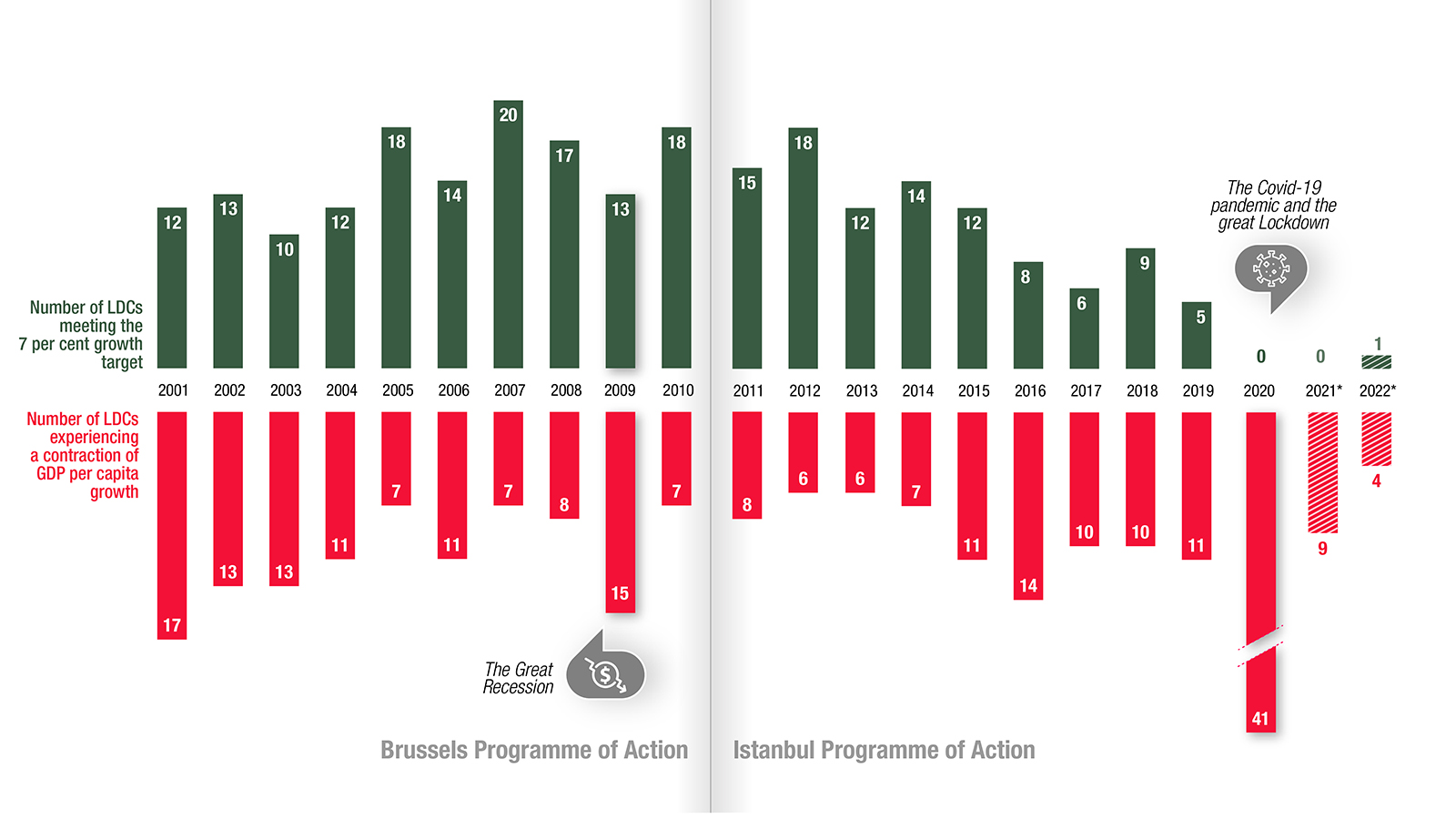The COVID-19 pandemic poses a challenge for sustainable development prospects in least developed countries (LDCs), as containment and lockdown measures have resulted in an economic slowdown for the group as a whole and for African LDCs in particular.

Source: UNCTAD secretariat calculations based on data from UNCTADstat database
Notes: * data for 2021 and 2022 are forecasts based on World Economic Outlook (October 2021) chained growth rates. There are currently 46 countries on the UN list of LDCs.
In 2001, the international community deemed a yearly growth rate of at least 7% necessary to eradicate poverty in LDCs and put their economies on a path of accelerated growth and sustainable development. The goal was introduced in the Brussels Programme of Action (BPoA) and then reaffirmed in 2011 in the Istanbul Programme of Action (IPoA) and enshrined in the 2030 Agenda for Sustainable Development, under target 8.1 of the Sustainable Development Goals (SDGs).
Despite large differences in growth performance among individual countries in the group, the January edition of UNCTAD’s LDC Chart of the Month reveals the extent to which the 7% growth target was unreachable for most LDCs even before the pandemic.
Insufficient and unsustained early progress
Unfortunately, the progress made to enable LDCs to move towards graduation under IPoA was inadequate. Low productive capacities, limited economic diversification, dependence on natural resources and high trade costs remain among the major obstacles they face to achieving sustained economic growth and development.
Each year during the BPoA period, from 2001 to 2010, an average of 15 out of 46 LDCs attained the target growth rate, while 10 on average suffered a contraction in real GDP per capita.
The situation, however, started to deteriorate progressively under the IPoA. In the early 2010s, as commodity prices began to slide, so did the number of LDCs meeting the 7% growth target, even though several West African countries recorded high growth rates between 2011 and 2015.
Inversely, the chart reveals a relative increase in the number of LDCs experiencing real declines in GDP per capita during the same period. The divergence became more pronounced after 2016.
Goal pushed further out of reach by COVID-19
COVID-19’s economic fallout – and the current uneven global recovery – has only pushed the goal further out of reach for most LDCs. UNCTAD analysis shows, for example, that it could take five or more years for one third of LDCs to recover to their already low pre-pandemic levels of GDP per capita – a proxy indicator for the average standard of living.
In 2020, the median gross national income per capita for LDCs was $905, compared with $3,970 and $24,085 for other developed countries and developed countries, respectively.
Four key messages
Beyond underscoring that the IPoA target remains largely unfinished business, the chart illustrates four key messages:
- First, despite some improvements, the IPoA growth target and progress towards achieving structural transformation and income convergence with more developed countries was already elusive for the majority of LDCs well before the pandemic. COVID-19 only further exposed many of the long-standing flaws and asymmetries of the prevailing multilateral trade and financial architecture.
- Second, the pandemic has dealt not only a serious blow to the achievement of the IPoA but also risks jeopardizing the attainment of the SDGs, unless vaccine inequality and uneven access to development finance are addressed in a more equitable and structural way. In this dire context, the fact that LDCs are relatively more dependent on ODA than other developing countries makes the call to meet long-standing aid targets (SDG 17.2) all the more urgent for a broad-based and resilient recovery.
- Third, given the number of LDCs suffering real declines in GDP per capita, the growth record of the last 20 years represents a strong reminder of the vulnerability of the world’s poorest countries to boom and bust cycles, such as those observed in commodity markets. Deep growth collapses in this context should be averted through concerted national and international efforts, as they may not only entail dramatic socio-economic costs but also exert lingering damage to potential output and exacerbate social tensions and political instability.
- Fourth, with the 5th UN Conference on Least Developed Countries (LDC5) set to take place this year, the international community must redouble its efforts to support building resilience in the LDCs. This calls for a new generation of International Support Measures for these vulnerable nations. More fundamentally, it calls for a renewed approach that puts developing the productive capacities of LDCs and fostering their structural transformation at the centre of development discourse.
Downloads:
-
UNCTAD’s Least Developed Countries Report 2021: The least developed countries in the post-COVID world – Learning from 50 years of experience
-
UNCTAD’s Least Developed Countries Report 2020: Productive Capacities for the New Decade.
-
UNCTAD’S Least Developed Countries Report 2019: The Present and Future of External Development Finance – Old Dependence, New Challenges.


